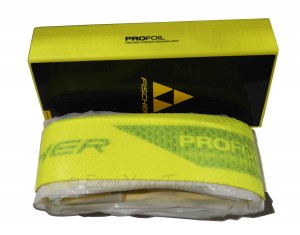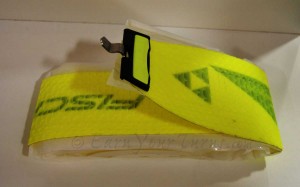The few leathernecks I ran in to in the trade show aisles all recalled Voile’s Snake Skins, plastic, strap-on, climbing skins with no glide. Just looking at the Fischer ProFoil there’s no question these skins glide well.
Nor is there any question the plastic crown pattern works for climbing, but is typically found to only cover the zone under your feet. Thus, there are limits to how steep you can climb. With ProFoil skins, Fischer’s crown pattern extends for the entire length of the base. Thus, it isn’t too much of a stretch to imagine they can climb a lot steeper than waxless, metal edged skis allow.
One Run View
To find out what the limit might be I did a short skin up the slopes of Copper Mountain during SIA’s on-snow demo day. An inch of fresh had fallen at dawn, and temps were in the high teens; cold enough that fish scaled skis have a hard time maintain a reliable grip above a 10° track. For comparison, one ski was outfitted with a Pomoca mohair skin, the other, with Fischer’s new ProFoil skin.As luck would have it, there was a short run roped off by ski patrol that provided 3 inches of untracked snow on old packed and refrozen snow; classic dust on crust that can be difficult to skin steeply. Indeed the limit of how steep I was able to skin and maintain grip was more due to the lack of adhesion from the surface to the firm base. Both the mohair and ProFoil patterned skin held steady and secure to 25°, occasionally 28°. Around 30° they gripped the snow, but the snow couldn’t hold to itself.
I’m sure that some skins can out climb the ProFoils, but 25° is sufficient, even respectable in a macho way. Where Fischer made claims was about the superior glide of Profoil skins compared to traditional skins. In my short comparison tour there was little discernable difference in the glide between the mohair or patterned base. The snow was cold and dry, not the best conditions to maximize glide. I have little doubt that with warmer, wetter snow the Profoils will put even the glide of mohair to shame.
That’s another advantage of the Profoil concept. Being made of plastic, they won’t absorb moisture which causes traditional climbing skins to stretch, ice-up, and gain weight. They attached to the base of your ski with a tradition adhesive, but because of their rigid nature, they are stored by folding in a Z-pattern, and then slide inside a plastic storage box. Or, instead of storing glue-to-glue, you can fold them up with glue-to-pattern without worrying about fibers sticking to the glue.
It will take a bit of time to sort out what the real limits of Fischer’s Profoil climbing skins are. For the moment, their advantages appear to outweigh any disadvantages. They will be available pretrimmed with a Z-style tip clip for use with Fischer’s backcountry ski line, or with a universal tip loop and a width of 110mm to be trimmed to your skis profile.Fischer
ProFoil
MSRP: $150
Weight:
© 2015





15 comments
Skip to comment form
pretty interesting. so it sounds like you think, but are not quite sure, that they can go as steep as mohair/nylon skins? While I agree lower angle is better, sometimes you just need to climb steep.
Agreed, sometimes you just need to go straight up steep. This was a one run test, and they held as well as mohair. It will take more time to be more definitive on their limits in various types of snow which, as you know, also affects how grippy a skin is.
Any feeling for how the plastic would handle low temperatures?
Looks like a clever innovation on Fischer’s part.
Theoretically the same as your ski bases since it is extruded P-Tex (I think). Are you afraid it will crack?
Yeap, especially repeated folding in the same place if it is really cold might be a weak point, but it is just a premonition from my behalf. Interesting enough though!
How do these skins compare to traditional nylon skins in terms of weight and packability (size in your pack)?
Seems really interesting if it could be made to glide significantly better than a skin–I’m thinking long rolling approaches to get to the real up/down as in the Adirondacks…but if the glide isn’t a lot better than regular skins, what’s the advantage? Are they stiff enough you could cut the center out of them so only the edges had grip without rolling and becoming impossible to handle?
The glide of waxless skis is heavily influenced by the type of snow they’re gliding on. Thus, I estimate the ProFoils will glide significantly faster in less dry snow, which is more common, at least on the wet coast. I also think my test was flawed for gliding speed. It really needs to be done with a matched pair through a “speed” trap and compare the times, or maybe one ski at a time, which I did not think to do.
Dry snow pretty common around here, especially this winter…dang I wish it would get above zero, just once this feb? Anyway, I also thought perhaps a “skin” like this with a traditional waxless base (glide on tip and tail and scales only on center 1/3-ish) could be really interesting. Probably I’m the only one interested though! 🙁
According to Fischer they pack down small.
I’ve put in an in-area uphilling day testing, then over the last 2 days I put about 13mi/20k miles on these skins in the Cascades in very wet snow, route-finding and putting in new skin track through below-treeline alpine terrain. It included a lot of downhill with skins on because we had to hack around through the trees a fair amount. I was very satisfied with them.
Note: It is important to note that a separator sheet is required for the tail end, but it is only about 18in/45cm long and very thin and flexible, so it is not hard to tuck into a pocket or into the stuff sack while changing over. Just about anything but clear color would be better. Also, you fold them at specific, well-defined creases. They get very flat, but because they are stiff they do not tuck into a coat easily.
Plus Plus!: They weighed the same at the top of the pass after 7 miles of skinning in 38F/3C rain as they did when I started.
Minus: The tail hook is simple, but they loosen a little too easily. You can’t just set it and forget it. I had to adjust it on the tour a couple times. Maybe it is the strap either slipping or stretching when it is wet?
Plus: Part of our route included a groomed downhill road (not long enough to want to take the skins off). As I glided by (slowly), one of my partners on traditional skins said, “I’m feeling kind of jealous about now.” They also seemed less grabby, more predictable, and with relatively good control when skiing down short stretches
Needs watching: The creases at the fold “hinges” don’t stay flat on the ski if you are not standing on them. I did not experience any bad ice buildup under the skin, but I will have to see what happens as the glue gets more worn.
Minus: I highly doubt they are re-gluable
Overall I really like them! This is an innovative product that has some real advantages. I have zero regrets taking a chance on them. My major questions are mostly about durability:
Will the folds tear or break?
How will the glue last?
Thanks for posting about your experience. Good to hear.
Nah, there’s maybe three people globally!
Remember Voile Snake Skins? They did OK provided you had no expectation of glide and no need of critical edging in a no-fall zone.
I should place a caveat that we had a packed skintrack doing sweep after 60 skiers on a backcountry race course, but no real ice, and no death-defying edge-hold situations. I suspect a lot of people might opt for crampons in those conditions.